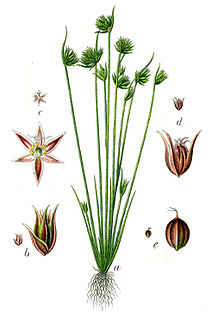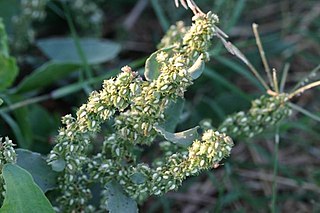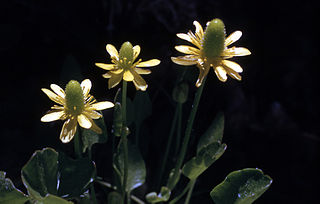
Rumex longifolius, commonly known as the dooryard dock or northern dock, is a perennial species of plant in the genus Rumex.

Grindelia stricta is a species of flowering plant in the daisy family known by the common names Oregon gumplant, Oregon gumweed and coastal gumplant. It is native to the west coast of North America from California to Alaska, where it is a resident of coastal plant communities such as those in marshes and beaches. This plant is variable in appearance, taking the form of a weedlike perennial herb forming low clumps to a sprawling subshrub growing erect to heights exceeding one meter. Its foliage and stems are green to rusty red or purplish and the plant may be hairy to hairless. The fleshy leaves are green, often with red edges and veining, and are up to 15 centimeters in length on large plants. The inflorescence holds one or more flower heads each up to 5 centimeters wide. The flower head is a cup of thick erect or recurved green phyllaries. Yellow disc florets fill the center of the flower head and there is a fringe of yellow ray florets around the circumference. The head produces copious amounts of white latex, especially in the early stages of blooming.

Juncus articulatus is a flowering plant species in the rush family Juncaceae. It is known by the common name jointleaf rush or jointed rush, which can also refer to J. kraussii from Australia. It is native to Eurasia, Canada, Greenland, and much of the United States. It grows in moist areas, such as wet sand, and thrives in calcareous soils. J. articulatus was found to be more sensitive to drought and salt stress than its congeners J. acutus and J. maritimus. It is a perennial herb producing mainly erect stems from a short rhizome. The stem may root at nodes, and it generally has one or more flattened hollow cylindrical leaves up to 10 centimeters long. Transverse internal partitions or joints may be seen or felt in the leaf of the plant.

Juncus capitatus is a species of rush known by the common names dwarf rush and leafybract dwarf rush. It is native to Europe, Asia and North Africa. It is also an introduced species in parts of North America such as California and the Gulf Coast. It grows in moist areas, such as wet sand, vernal pools, and ditches.

Juncus ensifolius is a species of rush known by the common names swordleaf rush, sword-leaved rush, and three-stamened rush. It is native to much of western North America from Alaska to central Mexico, and into eastern Canada. It is present in Japan and far eastern Russia, and it has been introduced to many other regions of the world, including Europe, New Zealand, Hawaii, and Australia. It is a plant of wet areas in many types of habitat. This is a rhizomatous perennial herb forming clumps of stems 20 to 60 centimeters tall. The flat but curving leaves are mostly located at the base of the stems and are variable in length. The inflorescence is an array of many rounded clusters of many flowers each. Each flower has a number of dark brown to black tepals a few millimeters long and usually three small stamens enclosed between them. The fruit is an oblong capsule with a small beak on the tip.

Calycadenia multiglandulosa is a species of flowering plant in the sunflower family, known by the common names sticky calycadenia and sticky western rosinweed. It is endemic to California, where it is a common in the Coast Ranges and in the Sierra Nevada Foothills from Shasta County to Kern County.

Rumex stenophyllus is a species of flowering plant in the knotweed family known by the common name narrow-leaf dock. It is native to Eurasia and it can be found in parts of North America as an introduced species and roadside weed. It grows in moist and wet habitat, often in areas with saline soils. It is a perennial herb producing an erect stem from a thick taproot, usually measuring 40 to 80 centimeters tall, but known to well exceed one meter. The leaves are up to 30 centimeters long and are generally lance-shaped with curled edges. The inflorescence is an interrupted series of clusters of flowers with 20 to 25 in each cluster, each flower hanging from a pedicel. The flower has usually six tepals, the inner three of which are largest, triangular and edged with teeth, and bearing tubercles.
Chenopodium desiccatum is a species of flowering plant in the family Amaranthaceae known by the common names aridland goosefoot and slimleaf goosefoot.

Dysphania multifida is a species of flowering plant in the family Amaranthaceae known by the common names cutleaf goosefoot and scented gooosefoot.

Petrorhagia dubia is a species of flowering plant in the family Caryophyllaceae known by the common name hairy pink. It is native to southern Europe and the Mediterranean Basin, but it is known on other continents, including Australia and North and South America, as an introduced species and sometimes a weed. It is an annual herb growing 25 to 60 centimeters tall, but known to reach 90 centimeters in height. The leaves are up to 6 centimeters long, sheathing the stem at the bases. The inflorescence bears a head-like cluster of flowers, their bases enclosed in a large, expanded mass of wide, claw-tipped bracts. The flower corollas are each further encased in a tubular calyx of sepals. The petals are bright pink to magenta or lavender in color with darker veins. Each is heart-shaped or divided into two lobes at the tip. The fruit is a capsule containing many tiny seeds.

Phacelia ramosissima is a species of phacelia known by the common name branching phacelia. It is native to western North America from British Columbia to California and the Southwestern United States, where it can be found in many types of habitat.

Ranunculus cymbalaria is a species of buttercup known by the common names alkali buttercup and seaside buttercup. It is native to much of Eurasia and parts of North and South America, where it grows in many types of habitat, especially in moist to wet areas such as marshes, bogs, and moist spring meadows. It is a perennial herb producing several stems a few centimeters to nearly 40 centimeters long. Some are prostrate against the ground and are stolons which root in moist substrate, and some are erect. The leaves are variable in shape, the basal ones with notched or slightly divided leaf blades borne on long petioles, and any upper leaves much reduced in size. The inflorescence bears one or more flowers on erect stalks. The flower has five to eight pale yellow petals, each under a centimeter long. The protruding receptacle at the center of the flower becomes a cylindrical cluster of fruits, each of which is an achene.
Rumex dentatus is a species of flowering plant in the knotweed family known by the common names toothed dock and Aegean dock. It is native to parts of Eurasia and North Africa, and it is widely known elsewhere as an introduced species. It grows in disturbed habitat, often in moist areas, such as lakeshores and the edges of cultivated fields. It is an annual or biennial herb producing a slender, erect stem up to 70 or 80 centimeters in maximum height. The leaves are lance-shaped to oval with slightly wavy edges, growing to a maximum length around 12 centimeters. The inflorescence is an interrupted series of clusters of flowers, with 10 to 20 flowers per cluster and each flower hanging on a pedicel. Each flower has usually six tepals, the 3 inner of which are edged with spinelike teeth and have tubercles at their centers.
Rumex kerneri is a species of flowering plant in the knotweed family known by the common name Kerner's dock. It is native to Europe. It has also been observed in California as an introduced species and roadside weed. It is a perennial herb producing a slender, erect stem from a thick taproot, approaching 1.5 meters in maximum height. The lance-shaped leaves can be up to 25 centimeters long and have smooth, wavy, or wrinkly edges. The inflorescence is an interrupted series of clusters of flowers, with 15 or 20 in each cluster, each flower hanging from a pedicel. The flower has usually six tepals, the inner three of which are largest, about 6 millimeters long, edged with tiny teeth and bearing rounded tubercles in the centers.

Rumex paucifolius is a species of flowering plant in the knotweed family known by the common name alpine sheep sorrel.

Rumex salicifolius is a species of flowering perennial plant in the knotweed family known by the common names willow dock and willow-leaved dock. It is native to much of western North America, and more specifically, in southern and central parts of California, and some parts of Arizona and Nevada. It can also be found in parts of Europe as an introduced species and a roadside weed. It is an extremely variable plant which is generally divided into many varieties, some of which may actually be specimens of other species.

Sagittaria sanfordii is an uncommon species of flowering plant in the water plantain family known by the common names valley arrowhead and Sanford's arrowhead. It is endemic to California, where it is known from a few scattered occurrences on the North Coast and in the Central Valley. Many occurrences previously noted in the Central Valley and in southern California have been extirpated as the plant's aquatic habitat has been lost to human activity.

Trifolium glomeratum is a species of clover known by the common names clustered clover and bush clover. It is native to Eurasia and North Africa and it is known elsewhere as an introduced species. It easily takes hold in disturbed areas, becoming a common weed. It is an annual herb growing decumbent to upright in form with mostly hairless herbage. The leaves are made up of oval leaflets up to 1.2 centimeters in length. The inflorescences occur in leaf axils, each a headlike cluster of many flowers. Each flower has a calyx of sepals with triangular points that bend outward, and a pink corolla.

Deinandra fasciculata, known by the common names clustered tarweed and fascicled spikeweed, is a species of flowering plant in the daisy family native to western North America.

Hedypnois rhagadioloides, the Cretanweed or scaly hawkbit, is a species of plant in the dandelion tribe within the sunflower family. It is native to the Mediterranean Region and neighboring areas from Canary Islands to Iran, and naturalized in Australia and in parts of the Americas.

















